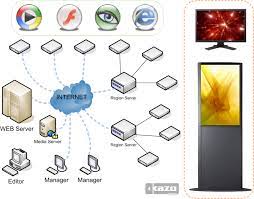Digital Signage System


A digital signage system is a network of displays that are used to present digital content such as video, images, and information. These systems can be used in a variety of settings, including retail stores, restaurants, corporate buildings, and public spaces.
Introduction:
Digital signage systems typically consist of hardware and software components. The hardware includes the display screens, as well as any necessary media players or other hardware required to run the system. The software includes the content management system, which is used to create and schedule the content that is displayed on the screens.
Digital signage systems can be used for a variety of purposes, including advertising, wayfinding, and providing information to customers or employees. They can be controlled remotely and can be updated in real-time, making them a flexible and efficient way to communicate with a large audience.
What Is Digital Signage System:
Digital signage is a type of electronic display that is used to present digital content, such as videos, images, and text. It is typically used in public spaces, such as retail stores, airports, and corporate buildings, to communicate information or advertisements to a large audience.
A digital signage system is a network of digital signage displays that are used to present this digital content. It typically consists of hardware, such as the display screens and media players, and software, such as the content management system (CMS) that is used to create and schedule the content that is displayed on the screens.
Digital signage systems can be controlled remotely and can be updated in real-time, making them a flexible and efficient way to communicate with a large audience. They can be used for a variety of purposes, including advertising, wayfinding, and providing information to customers or employees.
How It Works Digital Signage System:
Digital signage systems work by displaying digital content on electronic displays. The content is typically created and scheduled using a content management system (CMS), which is a software program that is used to create, manage, and schedule the content that is displayed on the screens.
The CMS is typically accessed through a web-based interface, which allows the user to create and upload content, schedule when and where it will be displayed, and monitor the performance of the system. The CMS can also be configured to display different content at different times of the day or in response to certain triggers, such as the weather or the time of day.
The digital signage displays are connected to a media player, which is a device that is responsible for displaying the content on the screens. The media player can be a standalone device or it can be built into the display. The media player receives the content from the CMS and displays it on the screen according to the schedule that has been set.
In some cases, the digital signage system may also be connected to other systems, such as point-of-sale systems or customer relationship management systems, to display real-time information or to trigger certain actions based on certain events.
Overall, digital signage systems work by displaying digital content on electronic displays, using a CMS to create and schedule the content, and using media players to display the content on the screens.
Conclusion:
In conclusion, digital signage systems are networks of electronic displays that are used to present digital content, such as videos, images, and text, to a large audience. These systems typically consist of hardware, such as the display screens and media players, and software, such as the content management system (CMS) that is used to create and schedule the content that is displayed on the screens. Digital signage systems can be used for a variety of purposes, including advertising, wayfinding, and providing information to customers or employees. They are controlled remotely and can be updated in real-time, making them a flexible and efficient way to communicate with a large audience.
What We Should Know About It Digital Signage System:
Here are some key things to know about digital signage systems:
- Digital signage systems consist of hardware and software components. The hardware includes the display screens, media players, and any other necessary hardware, while the software includes the content management system (CMS) that is used to create and schedule the content that is displayed on the screens.
- Digital signage systems can be used for a variety of purposes, including advertising, wayfinding, and providing information to customers or employees.
- Digital signage systems can be controlled remotely and can be updated in real-time, making them a flexible and efficient way to communicate with a large audience.
- Digital signage systems can be connected to other systems, such as point-of-sale systems or customer relationship management systems, to display real-time information or to trigger certain actions based on certain events.
- The effectiveness of a digital signage system depends on the quality of the content, the placement and size of the displays, and the overall design of the system. It is important to carefully plan and design a digital signage system to ensure that it is effective in achieving its intended goals.
If you want to get amazing benefits by using this link






